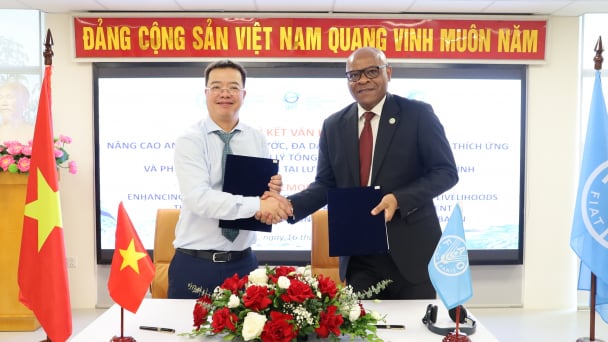May 20, 2025 | 12:15 GMT +7
May 20, 2025 | 12:15 GMT +7
Hotline: 0913.378.918
May 20, 2025 | 12:15 GMT +7
Hotline: 0913.378.918

Leaders of the Ninh Binh Department of Agriculture and Rural Development inspect an oyster seed farming household in Kim Trung commune, Kim Son district, Ninh Binh province. Photo: Huy Binh.
According to Mr. Pham Huy Trung, officer of the Ninh Binh Sub-Department of Fisheries, to develop and protect oyster farming areas, every year the Ninh Binh Provincial People's Committee issues a plan on seafood disease prevention and control.
Ninh Binh Department of Agriculture and Rural Development regularly supervises and speeds up relevant agencies and branches to strengthen review and guide people on disease prevention methods with the criterion 'prevention is better than cure'.
Ninh Binh Sub-Department of Animal Husbandry and Veterinary Medicine also regularly coordinates with the Central Veterinary Diagnostic Center to take samples to monitor diseases in farmed seafood in Kim Son district.
This agency also requested the District Department of Agriculture and Rural Development to direct and guide the People's Committees of communes to announce the results of disease surveillance sample testing and widely disseminate information about disease surveillance results on the commune-level radio system to warn people. Proactively implement farming measures for biosafety and disease safety. Regularly follow and closely monitor the area to inspect, supervise, and guide farming households on measures to treat the environment of farming ponds; and practice disease prevention and control.
In the case of detecting unusual deaths of farmed seafood, promptly inform the District People's Committee and the Sub-Department of Animal Husbandry and Veterinary Medicine to coordinate inspection and take samples for disease testing and diagnosis to handle and control the epidemic promptly in accordance with the provisions of Circular No. 04/2016/TT-BNNPTNT dated May 31, 2016 of the Ministry of Agriculture and Rural Development regulating disease prevention and control for aquatic animals.

An oyster seed farming area in Kim Trung commune, Kim Son district, Ninh Binh province. Photo: Huy Binh.
In particular, the Ninh Binh Sub-Department of Animal Husbandry and Veterinary Medicine clearly stated that it is necessary to regularly monitor abnormal signs on oyster seeds in terms of attachment density and the attachment position of oysters on the farming line. If there are a lot of oysters on the upper layer of the farming line, it means the bottom has a problem, such as a low pH, too thick bottom mud with a lot of algae, or many toxic gases at the bottom, etc. Until then, it is necessary to clean the bottom and adjust the attachment to loosen it.
According to Mr. Trung, fisheries experts recommend that Perkinsus Marinus disease has the capability of spreading very quickly. Moreover, there is currently no effective treatment solution for this disease. Accordingly, to prevent and limit the spread of this disease, farmers need to take integrated disease prevention measures, including choosing quarantined breeds, maintaining a reasonable farming density, and not stocking in water areas that are too shallow.
Seeds should be bathed in fresh water before stocking to remove spores of Perkinsus sp. Only seeds that ensure quality are stocked. It is necessary to regularly monitor and inspect water environmental factors such as temperature, salinity, etc. in the farming area to have timely solutions when environmental factors are unfavorable. Check growth and survival rates periodically. Be sure to check on farmed animals immediately after unusual weather phenomena such as storms, epidemics, or prolonged heavy rain or heat.
When mollusks reach harvest size, they should be harvested early to avoid damage. For mollusks that have not yet reached harvest size, the density should be spread out so that the stocking density is not too thick. The appropriate density for the seed size of 400–600 heads/kg is 180–200 heads/m2. The seeds with a size of 600–800 heads/kg should be raised at a density of below 250 heads/m2. With a seed size of 800–2,000 heads/kg, seeds should be stocked with a density of 250–300 fish/m2.
Perkinsus Marinus parasitizes the gill, mantle, intestinal epithelial cells, connective tissue organizations of the digestive gland, and gonads of bivalve mollusks. It is transmitted directly between mollusks without the need for vectors.
Therefore, when there is a phenomenon of dead clams and mussels, they need to be collected and treated to avoid spreading to living individuals. It is also necessary to take measures to clear stagnant water areas to avoid the phenomenon of stagnant water.
Translated by Huyen Vu Thu

(VAN) In 2024, over 295 million people across 53 countries and territories faced acute hunger—an increase of almost 14 million people compared to 2023, while the number of people facing catastrophic levels of hunger reached a record high.

(VAN) World Environment Day 2025 (June 5) carries the theme 'Beat Plastic Pollution' continuing to emphasize the global urgency of addressing the plastic waste crisis.

(VAN) This was the assessment shared by experts at the workshop titled 'Assessing the Role and Potential of Low-Emission Rice Production Systems in Vietnam,' held on the morning of May 19.

(VAN) Cai Rong Port is the fisheries control center of Quang Ninh, helping to monitor fishing vessels, combat IUU fishing, and remove the EC's 'yellow card'.

(VAN) The German Agricultural Society (DLG) explores the possibility of establishing a mechanization service center in Vietnam’s Mekong Delta to support farmers in accessing and utilizing advanced machinery.

(VAN) On May 16, the Department of Water Resources Management, in collaboration with the Food and Agriculture Organization of the United Nations (FAO), held a signing ceremony for the GEF-8 project document.

(VAN) Food safety, mechanization, vocational training, and market opening are key areas of cooperation expected between the Vietnamese Government and the Federal Republic of Germany.